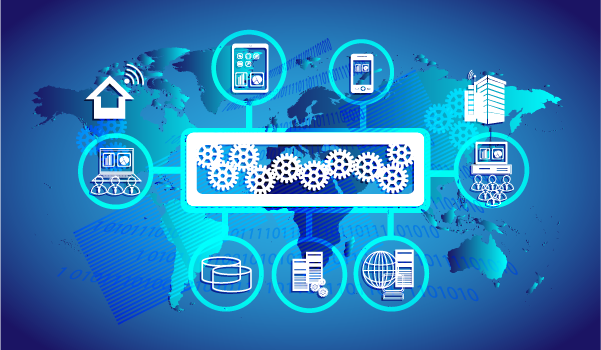Simplifying Integration with AI - Four Trends To Watch
As enterprises become more and more distributed, the hunt is on for smarter and faster ways to design and deploy integrations. IBM's Tony Curcio shares with IDN 4 ways AI-powered integration is changing the game for apps, data and even business workflows.
by Tony Curcio, Director of Product Management, IBM Automation
Tags: AI, APIs, data mapping, data transformation, IBM, integration, machine learning,

director of product management, IBM Automation

"AI is the fuel powering smarter integration, helping organizations reclaim upward of 50% of project time and achieve higher-quality outcomes."
 Integration Powers Digital Transformation for APIs, Apps, Data & Cloud
Integration Powers Digital Transformation for APIs, Apps, Data & CloudAugust 26, 2021
Many of the enterprises we speak with are focused on decentralization of their IT functions – including integration.
For some of these companies, that has to do with budget shifts from a central IT organization out to a line of business. In other cases, this may be a results of executing a global strategy that requires specific IT processes to remain in a country where they operate. Whatever the case, the intent is to improve business outcomes through faster time to value, lower costs and increased innovation.
To achieve this decentralization, business leaders are seeking smarter alternative technologies that can help them scale across their enterprise. They must avoid large upfront learning costs in training and mentoring before their teams can be successful. At the same time, these tools must still be powerful enough to tackle the complex business challenges that everyone faces.
So, what is the secret ingredient for such tools which can cater to both experts as well as less skilled line of business users? There's no guessing here - it’s Artificial Intelligence.
AI is the fuel powering smarter integration, helping organizations reclaim upward of 50% of their project time while reducing the expertise barrier and achieving higher-quality outcomes.

Let’s explore 4 of the key areas where the right AI-powered tooling can help deliver faster, smarter and more efficient integration.
1. AI-powered Data Mapping
When building integrations, data mapping is the process by which a user specifies how data elements from a source application correspond to elements in a target application. Data mapping has long been a point of frustration for developers since mapping fields between different endpoints is complex and time-consuming, slowing the speed at which businesses can respond to changes and remain competitive.
AI-powered tooling for data mapping uses pre-trained AI algorithms to securely provide users with intelligent, customized data mapping suggestions while building integration flows. It lets you automatically map high confidence suggestions from a curated and scored set of suggestions. Additionally, such technology should provide these benefits:
- Ready to use - AI/ML algorithm should be pre-trained to start working as soon as you do, you don’t have to train it to get going
- Comprehensive - considers all previous applications in a flow when offering mapping suggestions not just the immediately previous node. It should also provide suggestion for nested complex objects, arrays, and custom objects along with flat objects.
- Closed-loop AI - It should learn from your flow's mappings, retrain its AI model, and offer customized suggestions relevant to your mapping patterns. So, the next time you are trying to build a similar mapping for a different application, it would offer these tailored suggestions based on your past usage pattern.
- Private and secure - What AI learns working on your technologies is your intellectual property and is securely stored. Even in the cloud, this should stay private to your org – unless you specifically want to share it
2. AI-powered Data Transformation
After data mapping, data transformation is the next immediate challenge users face while building integration flows. Data from source systems often needs to be restructured (or transformed) into another format which target systems can understand and process. It’s a time-consuming exercise which requires moderate technical skills for building the transformation expression.
Take for example the illustration below where a user needs to reformat the mobile phone number. Rather than write custom logic to do that, he should be able to provide sample values that illustrate his intent - what he wants the output to look like. At that point, the AI should automatically inspect the examples and generate the transformation logic.
|
Source Data |
Target Data |
|
+44 7911 123456 |
07911123456 |
|
+44 7711 234567 |
07711234567 |
|
+44 7822 345678 |
07822345678 |
In addition, a transformation generator should also auto-generate logic for how data values (or code sets) are mapped between heterogeneous applications – as shown in the following example.
|
Source Data |
Target Data |
|
Open – Not Contacted |
OPEN |
|
Working – Contacted |
IN_PROGRESS |
|
Closed – Converted |
CONNECTED |
|
Closed – Not Converted |
UNQUALIFIED |
Additionally, such technology should provide these benefits:
- Optimized expressions - generate the optimized expression which an expert would have generated manually with years of expertise.
- Variety of use cases –address a variety of common scenarios like transformation of date formats, telephone format, address format, string case changes, mapping sets etc.
- Accelerates learning – The user doesn’t need to know any expression language to get started, but as they work, the AI illustrates the result. Not only does this provide transparency for what is being done on their behalf, but it also presents a learning opportunity in context.
3. AI-powered Flow Generation
Over the past two years, we’ve made significant progress in teaching computers to understand what a user is asking for in natural language. It’s now becoming increasingly common to be able to interact with a system from a hotel, insurer, bank, or government through a chat interface. Those same technologies can now also be used to help build integrations.
Natural Language Integration enables users to describe what they want to achieve. In response, the system leverages semantic understanding to interpret the user intent and then provides suggested flows that can be instantiated from that request.
Take for example the phrase “notify my team about new leads”. That requires understanding that the notion of a “lead” is specific to a few applications in your landscape – perhaps Marketo and Salesforce. The verb “notify” can mean to send an email or a slack. The phrase “my team” would need to be aware of structure within your organization. These notions can be aligned to a Knowledge Graph of the details of your specific organization in order to further refine context. Building up that context piece by piece suggests a handful of alternative flow layouts.
Of course, this is only scratching the surface since within each of the steps in the flow, the data will need to be mapped and transformed. Fortunately, a Natural Language Integration system can be built on the other AI technologies we previously discussed in order to fill out the remaining details.
4. AI-powered API Testing
With many new integration solutions using APIs to address business needs, it is critical that these APIs are thoroughly tested to reduce the chance for users to encounter errors. Unfortunately, many organizations do not feel that their existing API and Integration landscape has a sufficient level of testing. AI-powered API test generation capability can help provide better quality solutions, with lower impact on development skills and time.
AI in this area should ingest OpenTracing data from the API traffic to find unique scenarios in the data. This trace data should include not only the API request and response details, but also the details from the underlying integration or application components that also record trace information.
These traces form unique “fingerprints” that define a test scenario and are then compared against existing test cases. Where scenarios are not already covered as part of the test suite, the API test generation capability should then use automation, AI, and machine learning to generate potentially hundreds of new tests that reduce the potential for API users to encounter errors. These tests should also be customizable by the user through a no code interface where needed.
Conclusion
Any organization that is looking to scale out their integration platform beyond the walls of their center of excellence should consider the benefits of AI-powered tooling. Such capabilities reduce expertise requirements, speed time to value and improve outcomes.
Tony Curcio is Director of Product Management at IBM Automation For the past 20 years, Tony has been focused on helping organizations leverage data and application integration technologies to maximize the impact of their digital assets to fuel business transformation. His latest focus is Event Endpoint Management. To learn more, email Tony at tcurcio@us.ibm.com.
Related:
- Tray Advantage Program To Speed, Simplify AI-Powered Automation for Enterprises
- Removing Barriers to Business by Enabling Agility & Control with Ecosystem Integration
- 98% of Enterprises Struggle To Maintain, Rebuild Integrations for Key Business Apps
- ThreatX Adds API Visibility, Protection Capabilities To Defend Against Real-Time Attacks
- Visibility and Transparency are Climbing the List of C-Suite Priorities in 2022
All rights reserved © 2025 Enterprise Integration News, Inc.


